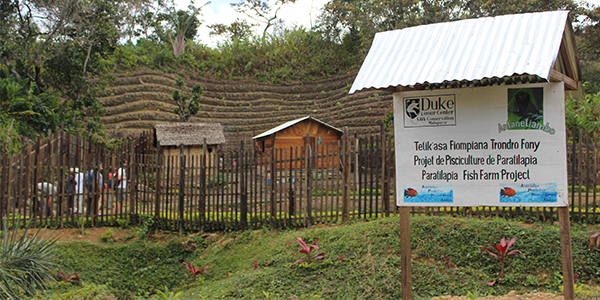Through training and partnership, promote the ability of Malagasy nationals to wisely manage their country’s environmental resources
Fish farms provide alternative protein and income
Lemurs as protein source – bushmeat for subsistence – has continued to grow in northeast Madagascar in the wake of political instability and breakdown of traditional hunting taboos (Patel Sep 2012 Newsletter). Additionally, income sources are few and the income small, and many people rely on rice agriculture to support their families and communities.
Fish farming provides an alternative to both of these issues. The Duke Lemur Center partners with the expert team of Guy Tam Hyock and his assistant Fidele to guide communities in the SAVA region on constructing and managing acre-sized fish ponds. The fish species is an endemic species of Paratilapia, locally known as fony. This species of freshwater fish is also considered endangered in the region’s rivers due to overfishing. Communities that choose to adopt fish farming agree to release one-fourth of the fish to local waterways to build up populations, and they may sell or eat the remaining three-fourths. Communities must also pass local laws to regulate fishing, including limits on size, number and even the size of the fishing net used.
Fuel efficient cook-stoves reduce dependence on forest resources
Meals in Madagascar’s poorer communities are cooked over a traditional “three-stone” fire using charcoal produced from forest resources. As population rises, so does the demand for charcoal for cooking food putting an increasing strain on dwindling forest cover. These open fires also contribute to respiratory health, especially among women and children working and cooking over the flames.
Duke Lemur Center-SAVA Conservation provides support to expand the use of ADES fuel-efficient “Rocket” stoves in the SAVA region. The Swiss-based organization ADES (Association pour le Developpement de l’Energie Solaire Suisse) constructs these fuel-efficient stoves out Swiss-made metal housings and Madagascar clay to create stoves that reduce charcoal use and burn cleaner reducing harmful air pollution. The DLC coordinated the use of the new stoves at campsites in Marojejy National Park. DLC-SC also purchases stoves from ADES and distributes them at reduced cost to make this option more affordable to the people of the region. In addition, DLC-SC continues to bring ADES representatives to the region to host demonstrations. Demand for the new stoves is high as we prepare to expand distribution.
Boots on the ground for Madagascar National Parks
It is critical that we do what we can to cooperate with and enable the Malagasy government in its effort to protect and manage the protected areas of the region. To that end, we have been working with Madagascar National Parks to support a “village guard” or CLP program, which enlists locals that live in villages along the periphery of Marojejy. A first step for the program is equipping the new guards for outdoor work in the rainforests of the Marojejy massif. DLC-SC transported to Madagascar more than 70 very sturdy American-made raincoats and purchased rubber boots in Madagascar.
DLC-SC also sponsored the demarcation of Marojejy National Park with signage. In an agreement with MNP, DLC SAVA Conservation is supporting clearly reestablishing the boundary of Marojejy NP, which had become overgrown with boundary signs deteriorated. The support enables MNP to have new signs made and put in place along 20 kilometers of the park boundary. An unmistakable boundary is an important tool for Park protection – not only does it clearly demarcate the edge of the Park, but it shows that protection is active in present terms. If all goes well with demarcation of this first section of the Marojejy NP boundary, DLC SAVA Conservation will support work on other sections.



